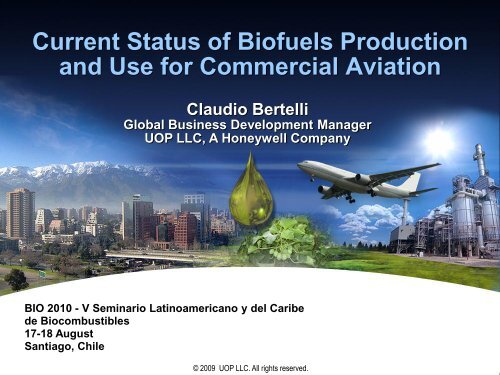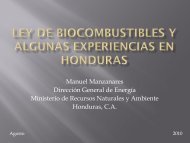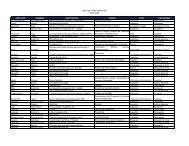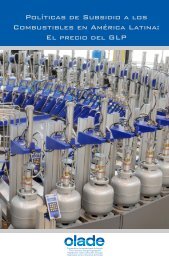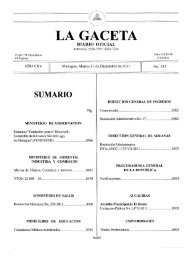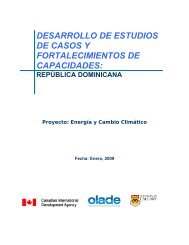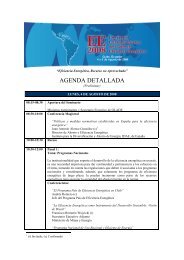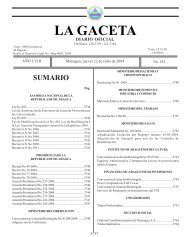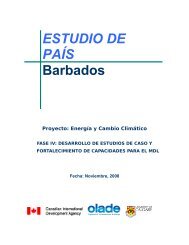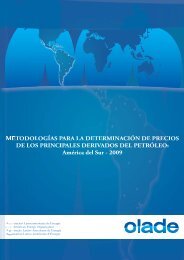Claudio Bertelli - OLADE
Claudio Bertelli - OLADE
Claudio Bertelli - OLADE
You also want an ePaper? Increase the reach of your titles
YUMPU automatically turns print PDFs into web optimized ePapers that Google loves.
Current Status of Biofuels Production<br />
and Use for Commercial Aviation<br />
<strong>Claudio</strong> <strong>Bertelli</strong><br />
Global Business Development Manager<br />
UOP LLC, A Honeywell Company<br />
BIO 2010 - V Seminario Latinoamericano y del Caribe<br />
de Biocombustibles<br />
17-18 August<br />
Santiago, Chile<br />
© 2009 UOP LLC. All rights reserved.
Discussion Topics<br />
� Introduction<br />
� Semi renewable jet fuel:<br />
Hydroprocessed renewable<br />
jet synthetic paraffinic<br />
kerosene (HRJ SPK)<br />
� Fully renewable jet fuel: The<br />
Path to 100% Renewable Jet<br />
Fuel
UOP Overview<br />
• Leading supplier and licensor of processing technology,<br />
catalysts, adsorbents, process plants, and technical<br />
services to the petroleum refining, petrochemical, and<br />
gas processing industries for over 90 years<br />
• UOP Technology Furnishes: 60% of the world’s<br />
gasoline; 70% of the world’s modern detergents;<br />
60% of the world’s para-xylene<br />
• ~3000 employees worldwide<br />
• ’08 Financials: ~$2 billion sales;<br />
• Strong relationships with leading refining and<br />
petrochemical customers worldwide<br />
• 70+ processes in 6,000+ units in hydrocarbon<br />
processing industry; 300+ catalysts, adsorbents; 31 of<br />
36 refining technologies in use today created by UOP<br />
2003 National Medal of<br />
Technology Recipient<br />
Track Record Of Technology Innovation
UOP Renewables Vision<br />
• Building on UOP technology and expertise<br />
• Produce real “drop-in” fuels instead of fuel additives/blends<br />
• Leverage existing refining, transportation, energy, biomass handling<br />
infrastructure to lower capital costs, minimize value chain disruptions,<br />
and reduce investment risk.<br />
• Focus on path toward second generation feedstocks & chemicals<br />
Oxygenated Biofuels<br />
Ethanol<br />
Biodiesel<br />
First<br />
Generation<br />
Natural oils from<br />
vegetables and<br />
greases<br />
Renewable<br />
Energy<br />
Fuel &<br />
Power<br />
“Other” Oils: Camelina, Jatropha<br />
Hydrocarbon Biofuels<br />
Diesel Jet Gasoline<br />
Second<br />
Generation<br />
Lignocellulosic<br />
biomass,<br />
algal oils
Index Index 100 100 =1990 =1990<br />
Market Drivers/Enablers<br />
Aviation Emissions Are Growing Rapidly<br />
180<br />
160<br />
140<br />
120<br />
100<br />
80<br />
EU GHG Emissions by Sector as an Index of 1990 Levels<br />
60<br />
1990 1991 1992 1993 1994 1995 1996 1997 1998 1999 2000 2001 2002 2003<br />
Int Aviation<br />
Energy<br />
Industrial Processes<br />
Agriculture<br />
Year<br />
Source: ICAO<br />
Waste<br />
Total (Without LUCF)<br />
Transport<br />
� EU Emission Trading Scheme<br />
extending to aviation sector:<br />
- Aviation emissions: Fastest<br />
growing of any sector<br />
- 2012 Emissions: 97% of 2005<br />
- 2013 Emissions, 95% of 2005<br />
� US Military‟s National Security<br />
driven goals to achieve both<br />
greater substitution (~50% by<br />
2020) & GHG reduction,<br />
� Aviation industry OEM‟s drive to<br />
render fleets compatible with<br />
upto 50% biojet<br />
� Major Airline initiatives to use<br />
biojet<br />
� Accelerated certification efforts<br />
� 2 nd gen feedstock initiatives:<br />
- Camelina, Jatropha, Algal
Forecast of Industry CO 2 Emissions<br />
Key Drivers of Emissions Reductions<br />
Presented to ICAO GIACC/3 February 2009 by Paul Steele on behalf of ACI, CANSO, IATA and ICCAIA<br />
Using Less Fuel<br />
- Efficient Airplanes<br />
- Operational Efficiency<br />
Changing the Fuel<br />
- Sustainable Biofuels<br />
Low carbon fuels a key part of emissions reduction
UOP RE&C Technologies & Capabilities<br />
Feed Process Product<br />
Natural Oil/Fats<br />
Hydrogen<br />
Natural Oil/Fats<br />
Hydrogen<br />
Biomass<br />
Ecofining TM<br />
Process<br />
Renewable Jet<br />
Process<br />
Envergent Technologies – UOP/Ensyn JV<br />
Rapid Thermal<br />
Processing<br />
(Pyrolysis)<br />
Green Diesel<br />
Green Jet (if req)<br />
Green Jet<br />
Green Diesel<br />
Green Power / Fuel Oil (now)<br />
Upgrading Process<br />
Green Fuels (2012)<br />
HVO: „000‟s<br />
barrels/day<br />
Sustainable technologies – feedstock flexible & 2nd Gen ready<br />
UOP Proprietary
Viable Sustainable Biofuel feedstock alternatives:<br />
Commercial Scale Production<br />
Algae<br />
Ready in 8 to 10 years<br />
Halophytes<br />
Ready in 5 to 7 years<br />
Challenges<br />
• Technological<br />
innovation<br />
needed for<br />
processing<br />
• Algal Oil<br />
extraction key<br />
hurdle<br />
Challenges<br />
• Proven at pilot<br />
scale<br />
• Improve<br />
agronomy for<br />
cost reduction<br />
Jatropha<br />
Ready in 2 to 4 years<br />
Camelina<br />
Ready Now<br />
Viability is based on timing, technology and local resources<br />
Challenges<br />
• Limited to warm<br />
climates only<br />
• Mechanical<br />
harvesting isn‟t<br />
mature<br />
Challenges<br />
• Limited total<br />
potential owing to<br />
yield<br />
• Somewhat tied to<br />
grain market<br />
swings
Honeywell Green Jet Fuel TM<br />
• Started under DARPA<br />
contract to develop process<br />
technology to produce<br />
military jet fuel from<br />
renewable sources.<br />
• Leverages Ecofining<br />
process technology.<br />
• Fuel meets stringent<br />
requirements for flight.<br />
• Military has ordered up<br />
to 600,000 gallons.<br />
• Extend to commercial<br />
aviation in partnership<br />
with OEMs.<br />
DARPA Project Partners<br />
Demonstration Flights
UOP Stage Gate Process for Process<br />
Development: Green Jet Process<br />
Offered Commercially<br />
Idea<br />
Generation<br />
Idea<br />
Screening<br />
Idea<br />
Validated<br />
Stage 1<br />
Scoping<br />
Gate 1 Gate 2<br />
Project<br />
Selection<br />
Scoping<br />
Studies<br />
Initiated<br />
Techno-Economic<br />
Evaluation<br />
Initiated<br />
Stage 2<br />
Concept<br />
Selection<br />
Dev’t<br />
Approval<br />
Stage 3<br />
Development<br />
Stage 4<br />
Gate 3 Gate 4 Gate 5<br />
Scale-up<br />
Approval<br />
Pending Decision<br />
to Proceed<br />
First<br />
Commercial<br />
Unit<br />
Product<br />
Launch<br />
Approval<br />
• Passed Gate 4 in December 2009<br />
• Ready For Process Design #1 in 1Q 2010<br />
Stage 5<br />
Product<br />
Launch<br />
Post-<br />
Launch<br />
Review<br />
Enables UOP to guarantee new technology
Renewable Jet (Bio-SPK) Chemistry<br />
Feedstocks<br />
Rapeseed<br />
Tallow<br />
Jatropha<br />
Soybean<br />
Algal Oils<br />
Palm Oil<br />
Camelina<br />
Greases<br />
HO<br />
HC<br />
O<br />
O<br />
O<br />
O<br />
O O<br />
O<br />
Free Fatty Acid<br />
Free MW=200-300<br />
Fatty Acid<br />
Triglyceride<br />
Triglyceride Feed<br />
MW=700-900<br />
CH 3<br />
CH 3<br />
CH 3<br />
CH 3<br />
H 2<br />
H 2O<br />
UOP Catalyst<br />
H 3C<br />
H 3C<br />
H 3C<br />
CH 3CH 3<br />
CH3 CH3 +<br />
+<br />
H 3C<br />
CH 3<br />
CH 3<br />
CH 3<br />
Feedstock flexible, but with consistent product properties<br />
CO 2<br />
H 2O +<br />
CO 2 H3C<br />
UOP Catalyst<br />
+ H 3C CH 3<br />
CH 2 +<br />
� Natural oils contain oxygen, have high<br />
molecular weight.<br />
� First reaction removes oxygen – product is<br />
diesel range waxy paraffins<br />
� Second reaction “cracks” diesel paraffins to<br />
smaller, highly branched molecules<br />
� End product is same as molecules already<br />
present in aviation fuel<br />
� End product is independent of starting oil<br />
H 3C CH 3<br />
H 3C<br />
CH 3<br />
H 3C H 3C CH 3<br />
Synthetic<br />
Paraffinic<br />
Synthetic Paraffinic Kerosene<br />
Kerosene<br />
Straight Chain Paraffins<br />
H 2<br />
CH 3<br />
CH 3
UOP Renewable Jet Process<br />
Feedstocks<br />
Rapeseed<br />
Tallow<br />
Jatropha<br />
Soybean<br />
Algal Oils<br />
Palm Oil<br />
Camelina<br />
Greases<br />
Deoxygenation<br />
Water<br />
CO 2<br />
Selective<br />
Hydrocracking<br />
Recycle<br />
Product<br />
Separation<br />
� Feedstock flexible<br />
� Optimised for 50% SPK yield<br />
� Makes valuable hydrocarbon co-products<br />
- Green Diesel<br />
- Green Naphtha<br />
- Green LPG<br />
� Ability to swing anywhere between „Max SPK‟ and „Max Green Diesel‟<br />
production to meet market demand<br />
Commercial scale, proven technology<br />
Hydrogen<br />
Light Fuels<br />
SPK<br />
(Green Jet)<br />
Green Diesel
Properties of SPK for Demo/Certification<br />
Description<br />
Jet A-1<br />
Specs<br />
SPK<br />
(Jatropha)<br />
SPK<br />
(Camelina)<br />
SPK<br />
(Jatropha/<br />
Algae)<br />
Flash Point, o C Min 38 46.5 42.0 41.0<br />
Freezing Point, o C Max -47 -57.0 -63.5 -54.5<br />
JFTOT@300 o C Filter dP, mmHg max 25 0.0 0.0 0.2<br />
Tube Deposit Less Than < 3 1.0
Use of Green Jet Fuel: Semi-Synthetic<br />
Jet Fuel (SSJF)<br />
� Green Jet Fuel can meet all<br />
the key properties of petroleum<br />
derived aviation fuel<br />
�Flash point<br />
�Freeze Point<br />
�Stability<br />
�Heat of Combustion<br />
� SPK does not contain aromatics<br />
so must be blended with a<br />
source of aromatics, such as<br />
fossil jet fuel<br />
Crude Oil<br />
Oil Refinery<br />
Fossil Jet Fuel<br />
Fully Fungible<br />
“drop-in”<br />
Renewable Fuel<br />
Natural Oils &<br />
Fats<br />
UOP Renewable<br />
Jet Process<br />
Synthetic<br />
Paraffinic<br />
Kerosene<br />
50-100% 0-50%<br />
A „drop-in‟ biofuel for aviation
D 7566 Annex 1 D 1655<br />
Synthetic Jet Fuels<br />
Petroleum<br />
Fischer-Tropsch (FT)<br />
Coal<br />
Natural<br />
Gas<br />
Biomass<br />
Gasify<br />
Hydroprocessed Renewable<br />
Jet (HRJ) from Bio-Oils<br />
Plant/Algae<br />
Oils<br />
Syn Gas<br />
(CO, H 2)<br />
Oil Extraction<br />
FT Process<br />
Synthetic Jet Fuels<br />
Crude Oil<br />
Syn-Crude<br />
Bio-Crude<br />
Conventional<br />
Refinery Processes<br />
Hydroprocessing<br />
Jet Fuel<br />
Slide courtesy of Mark Rumizen, FAA/CAAFI
ASTM D7566 Issued 1 st Sept 09<br />
D1655<br />
5.1 Materials and<br />
Manufacture<br />
Annex 3<br />
Table 1<br />
Blend Comp’s Criteria<br />
and Blend % Limits<br />
Other Adv<br />
Fuels or<br />
Processes<br />
Annex 2<br />
50% Bio<br />
SPK Fuel<br />
Blends<br />
Annex 1<br />
50%<br />
Hydpross’d<br />
SPK Fuel<br />
Blends<br />
Fuel Produced to D7566 Can<br />
Be Designated as D1655 Fuel<br />
D7566<br />
Av Turbine Fuel Containing<br />
Syn HC‟s<br />
Table 1<br />
Blended Fuel<br />
Performance<br />
Properties<br />
Slide courtesy of Mark Rumizen, FAA/CAAFI<br />
� Body of Spec Applies to<br />
Finished Semi-Synthetic Fuel<br />
� Annex for Each Class of<br />
Synthetic Blending<br />
Component<br />
� Allow Re-Certification to<br />
D1655<br />
� Annex 1<br />
- Hydroprocessed SPK<br />
� Includes 50% FT Fuel<br />
Certification of Bio-SPK to<br />
50% targeted for early 2011
Completed Flight Demonstrations<br />
� Successful ANZ Flight Demo Date: Dec. 30, 2008<br />
� Successful CAL Flight Demo Date: Jan. 7, 2009<br />
� Successful JAL Flight Demo Date: Jan. 30, 2009<br />
� KLM European Test Flight: November 23, 2009<br />
Feedstock:<br />
Jatropha oil<br />
Feedstock:<br />
Jatropha and algal oil<br />
Feedstock: Camelina,<br />
Jatropha and algal oil<br />
Camelina
Military Testing<br />
• Military demonstrations<br />
• Up to 600,000 gallons of fuel made from camelina,<br />
algae and animal fats for U.S. DESC<br />
• U.S. Air Force A-10 Thunderbolt II (camelina)<br />
• Navy F/A-18 Green Hornet (camelina)<br />
• Royal Netherlands Air Force Apache Helicopter<br />
(algae & used cooking oil)<br />
Green Jet Fuel Meets Flight Specifications
US Military Supply Contracts<br />
� US Military accelerating their biofuel certification program –<br />
- UOP is producing up to 600,000 gallons of jet fuel for an unprecedented HRJ-<br />
5/8 supply award from DESC<br />
Contract awarded:<br />
Line Volume<br />
item (gallons) Type of Fuel Feedstock Prime Producer Comment<br />
1 40,000 Navy HRJ5 Camelina Sustainable Oils UOP<br />
2 150,000 Navy HRJ5 Camelina Sustainable Oils UOP Optional amount<br />
3 100,000 AF HRJ8 Camelina Sustainable Oils UOP<br />
4 100,000 AF HRJ8 Tallow UOP (Cargill FS) UOP<br />
5 100,000 AF HRJ8 Camelina Sustainable Oils UOP Optional amount<br />
6 100,000 AF HRJ8 Tallow UOP (Cargill FS) UOP Optional amount<br />
7 1,500 Navy HRJ5 Algal oil Solazyme UOP<br />
All from 2 nd Generation Sustainable Feedstock
2 nd Generation Renewable Jet Fuel:<br />
Fully Renewable Jet Fuel from Oils<br />
and Biomass<br />
Natural<br />
Oils and<br />
Fats<br />
Solid<br />
Biomass<br />
Deoxygenation<br />
Pyrolysis<br />
Selective<br />
Cracking/<br />
Isomerization<br />
Catalytic<br />
Stabilization/<br />
Deoxygenation<br />
Green<br />
Jet-range<br />
paraffins<br />
Jet Range<br />
cyclic<br />
hydrocarbons<br />
Synthetic<br />
Paraffinic<br />
Kerosene<br />
Renewable<br />
Jet Fuel<br />
Renewable<br />
Jet Aromatics<br />
UOP 5016-10
The Future: 100% Renewable Jet<br />
The Boeing hydroplane ran on 98% Bio-SPK and 2% renewable<br />
aromatics at SeaFair, Seattle in Aug 2009<br />
Jet A1<br />
Spec Starting SPK<br />
Woody Pyrolysis Oil<br />
Aromatics<br />
Freeze Point ( o C) -47 -63 -53<br />
Flash Point ( o C) 39 42 52<br />
Density (g/mL) 0.775 0.753 0.863<br />
Woody Pyrolysis oil aromatics produced<br />
through a UOP-NREL-PNNL CRADA
Summary<br />
�UOP‟s Renewable Jet Process was rapidly developed<br />
through key collaborations and by leveraging UOP‟s world<br />
class hydroprocessing technology and expertise<br />
�UOP‟s Renewable Jet Process is ready to produce Bio-SPK<br />
in commercial quantities<br />
�A multidisciplinary team succeeded in producing and<br />
testing sustainable SPK<br />
�Certification of SPK to use in blends up to 50% is planned<br />
for early 2011.
Acknowledgements<br />
� AFRL<br />
- Robert Allen<br />
- John Datko<br />
- Tim Edwards<br />
- Don Minus<br />
� Air New Zealand<br />
- Grant Crenfeldt<br />
� Boeing<br />
- Billy Glover<br />
- James Kinder<br />
- Mike Henry<br />
- Darrin Morgan<br />
- Tim Rahmes<br />
- Dale Smith<br />
� CFM<br />
- Jerome A. Juenger<br />
� Continental Airlines<br />
- Gary LeDuc<br />
- Leah Raney<br />
- George Zombanakis<br />
� GE<br />
- Steve Csonka<br />
- Mike Epstein<br />
- M. Gurhan Andac<br />
� Japan Airlines<br />
- Takuya Ishibashi<br />
- Koichiro Nagayama<br />
- Yasunori Abe<br />
� NREL<br />
- Richard Bain<br />
� Nikki Universal<br />
- Yasushi Fujii<br />
- Masaru Marui<br />
� PNNL<br />
- Doug Elliot<br />
- Don Stevens<br />
� Pratt & Whitney<br />
- Tedd Biddle<br />
- Mario Debeneto<br />
- Kevin Reilly<br />
� Rolls Royce<br />
- Chris Lewis<br />
- Dave M. Lambert<br />
� Sustainable Oils<br />
- Scott Johnson<br />
� Targeted Growth<br />
- Tom Todaro<br />
� Honeywell / UOP<br />
- Amar Anumakonda<br />
- Roy Bertola<br />
- Andrea Bozzano<br />
- Tim Brandvold<br />
- Michelle Cohn<br />
- Graham Ellis<br />
- Matthew Griffiths<br />
- Jennifer Holmgren<br />
- Tom Kalnes<br />
- Joseph Kocal<br />
- Steve Lupton<br />
- Prabhakar Nair<br />
- Sunny Nguyen<br />
- Randy Williams<br />
- Jim Woodger<br />
Muchas Gracias!<br />
Preguntas?<br />
claudio.bertelli@uop.com<br />
DOE, Project DE-FG36-05GO15085 Paul Grabowski<br />
DARPA, Project W911NF-07-C-0049 Dr. Douglas Kirkpatrick


